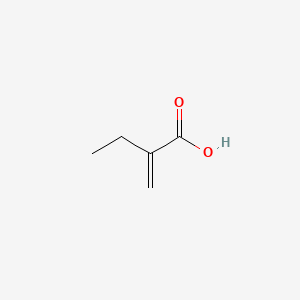| MeSH term | MeSH ID | Detail |
|---|---|---|
| Carcinoma, Basal Cell | D002280 | 6 associated lipids |
| Arrhythmias, Cardiac | D001145 | 42 associated lipids |
| Adenocarcinoma | D000230 | 166 associated lipids |
| Dermatitis, Contact | D003877 | 59 associated lipids |
| Dermatitis, Occupational | D009783 | 12 associated lipids |
| Lung Neoplasms | D008175 | 171 associated lipids |
| Body Weight | D001835 | 333 associated lipids |
| Edema | D004487 | 152 associated lipids |
| Bone Resorption | D001862 | 7 associated lipids |
| Brain Injuries | D001930 | 4 associated lipids |
2-Ethylacrylic acid
2-Ethylacrylic acid is a lipid of Fatty Acyls (FA) class. The involved functions are known as hemolysis.
Cross Reference
Introduction
To understand associated biological information of 2-Ethylacrylic acid, we collected biological information of abnormalities, associated pathways, cellular/molecular locations, biological functions, related genes/proteins, lipids and common seen animal/experimental models with organized paragraphs from literatures.
What diseases are associated with 2-Ethylacrylic acid?
There are no associated biomedical information in the current reference collection.
Possible diseases from mapped MeSH terms on references
We collected disease MeSH terms mapped to the references associated with 2-Ethylacrylic acid
PubChem Associated disorders and diseases
What pathways are associated with 2-Ethylacrylic acid
There are no associated biomedical information in the current reference collection.
PubChem Biomolecular Interactions and Pathways
Link to PubChem Biomolecular Interactions and PathwaysWhat cellular locations are associated with 2-Ethylacrylic acid?
There are no associated biomedical information in the current reference collection.
What functions are associated with 2-Ethylacrylic acid?
Related references are published most in these journals:
| Function | Cross reference | Weighted score | Related literatures |
|---|
What lipids are associated with 2-Ethylacrylic acid?
There are no associated biomedical information in the current reference collection.
What genes are associated with 2-Ethylacrylic acid?
There are no associated biomedical information in the current reference collection.
What common seen animal models are associated with 2-Ethylacrylic acid?
There are no associated biomedical information in the current reference collection.
NCBI Entrez Crosslinks
All references with 2-Ethylacrylic acid
Download all related citations| Authors | Title | Published | Journal | PubMed Link |
|---|---|---|---|---|
| Sakai T et al. | Prevention of fibrous layer formation between bone and adhesive bone cement: in vivo evaluation of bone impregnation with 4-META/MMA-TBB cement. | 2000 | J. Biomed. Mater. Res. | pmid:10906671 |
| Sakai T et al. | In vivo evaluation of the bond strength of adhesive 4-META/MMA-TBB bone cement under weight-bearing conditions. | 2000 | J. Biomed. Mater. Res. | pmid:10906683 |
| Bär FW et al. | New biocompatible polymer surface coating for stents results in a low neointimal response. | 2000 | J. Biomed. Mater. Res. | pmid:10906692 |
| Ferrero C et al. | Fronts movement as a useful tool for hydrophilic matrix release mechanism elucidation. | 2000 | Int J Pharm | pmid:10915923 |
| Fujisawa S et al. | Cytotoxicity of methyl methacrylate (MMA) and related compounds and their interaction with dipalmitoylphosphatidylcholine (DPPC) liposomes as a model for biomembranes. | 2000 | Oral Dis | pmid:10918558 |
| Wood ML et al. | Open reduction and cementation for femoral head fracture secondary to avascular necrosis: preliminary report. | 2000 | Iowa Orthop J | pmid:10934620 |
| Lewis G | Relative influence of composition and viscosity of acrylic bone cement on its apparent fracture toughness. | 2000 | Biomed Mater Eng | pmid:10950202 |
| Hasirci V et al. | High strength bioresorbable bone plates: preparation, mechanical properties and in vitro analysis. | 2000 | Biomed Mater Eng | pmid:10950204 |
| Böhler M et al. | Wear debris from two different alumina-on-alumina total hip arthroplasties. | 2000 | J Bone Joint Surg Br | pmid:10990321 |
| Shore PA et al. | A three-dimensional histological method for direct determination of the number of trabecular termini in cancellous bone. | 2000 | Biotech Histochem | pmid:10999569 |
